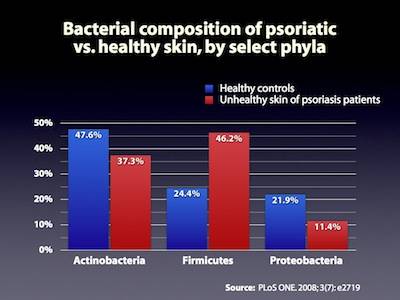
This is an old revision of the document!
Table of Contents
<IncompleteNotice>
Psoriasis
J Clin Microbiol. 2006 Aug;44(8):2933-41.Links
Molecular analysis of fungal microbiotaThe bacterial community which causes chronic diseases - one which almost certainly includes multiple species and bacterial forms. in samples from healthy human skin and psoriatic lesions. Paulino LC, Tseng CH, Strober BE, Blaser MJ. Department of Medicine, New York University School of Medicine, 550 First Ave., OBV-A 606, New York, NY 10016, USA.
Psoriasis, a common cutaneous disease of unknown etiology, may be triggered by infections, including those due to fungi. Since the fungal community of human skin is poorly characterized, we aimed to analyze the mycological microbiota in healthy skin and psoriatic lesions. Twenty-five skin samples from five healthy subjects (flexor forearm) and three patients with psoriasis were analyzed using broad-range 18S ribosomal DNA (rDNA) and 5.8S rDNA/internal transcribed spacer 2 (ITS2) Malassezia-specific PCR primers. Broad-range PCR analysis indicated that most organisms resembled Malassezia. Malassezia-specific 5.8S/ITS2 analysis of 1,374 clones identified five species and four unknown phylotypes, potentially representing new species. The species distribution appears largely host specific and conserved in different sites of healthy skin. In three subjects, the Malassezia microbiota composition appeared relatively stable over time. Samples of Malassezia microbiota from healthy skin and psoriatic lesions were similar in one patient but substantially different in two others. These data indicate the predominance of Malassezia organisms in healthy human skin, host-specific variation, stability over time, and as yet, no consistent patterns differentiating psoriatic skin from healthy skin.
PMID: 16891514
Exp Dermatol. 2010 Aug;19(8):e23-30. Topical calcitriol protects from UV-induced genetic damage but suppresses cutaneous immunity in humans. Damian DL, Kim YJ, Dixon KM, Halliday GM, Javeri A, Mason RS. Dermatology, Sydney Cancer Centre, Royal Prince Alfred Hospital, University of Sydney, Camperdown, NSW, Australia. Abstract Calcitriol, the biologically active form of vitamin D, has been reported to cause both suppressive and protective immune effects in mice. Its immune effects in vivoA type of scientific study that analyzes an organism in its natural living environment. in humans are unclear. We investigated the in vivo effects of topical calcitriol on minimal erythema dose and skin immune responses in healthy volunteers. We found that calcitriol did not protect from ultraviolet (UV)-induced erythema (sunburn) when applied either 24 h before or immediately after irradiation, although it decreased the density of sunburn cells and thymine dimers seen on biopsy when applied 24 h before and again immediately after irradiation. Using the Mantoux reaction as a model of skin immunity, we found that topical calcitriol applied at high total doses reduced the Mantoux responses of nearby untreated, unirradiated skin, suggesting a para-local or systemic immunosuppressive effect not observed with lower calcitriol doses. We then measured UV-induced suppression of Mantoux reactions at vehicle-treated sites and sites treated with low-dose calcitriol, and found that calcitriol neither reduced nor enhanced UV-induced immunosuppression. Despite calcitriol reducing UV-induced DNA damage, which should protect the immune system, it has immunosuppressive effects in our model which may help to explain the efficacy of analogues such as calcipotriol in the treatment of psoriasis.
PMID: 19758324
Evidence of infectious cause
Patient interviews
Notes and comments
<DiseaseHierarchy>
GETCONTENT
- legacy content



